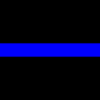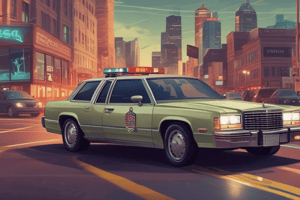Podcast
Questions and Answers
What is a visual cue of driving impairment for a motorcyclist?
What is a visual cue of driving impairment for a motorcyclist?
- Trouble balancing at a stop (correct)
- Driving at the speed limit
- Wearing a helmet
- Using turn signals
What does an impaired driver's difficulty with divided attention lead to?
What does an impaired driver's difficulty with divided attention lead to?
- Increased situational awareness
- Improved reaction time
- Difficulty steering and controlling the accelerator (correct)
- Enhanced night vision
Why should an officer not ask an impaired driver to move their vehicle to a safer location?
Why should an officer not ask an impaired driver to move their vehicle to a safer location?
- Because it may create an unsafe situation (correct)
- Because the driver may get lost
- Because it's not necessary
- Because the officer is not trained to do so
What is a common error made by an impaired motorcyclist?
What is a common error made by an impaired motorcyclist?
What is an additional cue of impairment that may occur when an officer directs a driver to stop their vehicle?
What is an additional cue of impairment that may occur when an officer directs a driver to stop their vehicle?
What is a visual cue of driving impairment for a motorcyclist at night?
What is a visual cue of driving impairment for a motorcyclist at night?
What is a divided attention task for a driver?
What is a divided attention task for a driver?
What is a result of an impaired driver's inability to divide attention?
What is a result of an impaired driver's inability to divide attention?
What is the maximum number of clues that can be observed for a driver during the walking stage of the walk-and-turn test?
What is the maximum number of clues that can be observed for a driver during the walking stage of the walk-and-turn test?
According to the instructions, what should the driver do with their arms during the walking stage of the walk-and-turn test?
According to the instructions, what should the driver do with their arms during the walking stage of the walk-and-turn test?
What is considered an improper turn in the walking stage of the walk-and-turn test?
What is considered an improper turn in the walking stage of the walk-and-turn test?
Which of the following is NOT a clue that an officer should look for during the walking stage of the walk-and-turn test?
Which of the following is NOT a clue that an officer should look for during the walking stage of the walk-and-turn test?
What is the correct distance between the heel and toe for each step during the walking stage of the walk-and-turn test?
What is the correct distance between the heel and toe for each step during the walking stage of the walk-and-turn test?
If a driver indicates they have a physical injury or limitation that would prevent them from completing the walk-and-turn test, what should the officer do?
If a driver indicates they have a physical injury or limitation that would prevent them from completing the walk-and-turn test, what should the officer do?
What is the correct starting position for the walking stage of the walk-and-turn test?
What is the correct starting position for the walking stage of the walk-and-turn test?
What is the total number of steps the driver should take during the walking stage of the walk-and-turn test?
What is the total number of steps the driver should take during the walking stage of the walk-and-turn test?
What is the primary purpose of Standardized Field Sobriety Tests (SFSTs)?
What is the primary purpose of Standardized Field Sobriety Tests (SFSTs)?
Which physiological process involves alcohol entering the bloodstream?
Which physiological process involves alcohol entering the bloodstream?
How does alcohol primarily affect motor skills in an impaired individual?
How does alcohol primarily affect motor skills in an impaired individual?
What factor does NOT influence the degree of alcohol's effect on a person?
What factor does NOT influence the degree of alcohol's effect on a person?
Which of the following is a common mental effect of alcohol?
Which of the following is a common mental effect of alcohol?
During which process does the body expel alcohol?
During which process does the body expel alcohol?
What is NOT a result of slowed reaction time due to alcohol consumption?
What is NOT a result of slowed reaction time due to alcohol consumption?
Which of these factors does NOT affect how alcohol is processed in the body?
Which of these factors does NOT affect how alcohol is processed in the body?
What should be the initial instruction to the driver before starting the HGN test?
What should be the initial instruction to the driver before starting the HGN test?
Which of the following instructions is NOT part of the HGN test administration?
Which of the following instructions is NOT part of the HGN test administration?
How should the testing object be positioned during the HGN test?
How should the testing object be positioned during the HGN test?
Which abnormality should be checked during the initial stage of the HGN test?
Which abnormality should be checked during the initial stage of the HGN test?
What is a key indicator of impairment observed during the HGN test?
What is a key indicator of impairment observed during the HGN test?
What should the officer do if resting nystagmus is observed?
What should the officer do if resting nystagmus is observed?
What indicates 'equal tracking' during the HGN test?
What indicates 'equal tracking' during the HGN test?
Which of the following objects is suitable for the HGN test?
Which of the following objects is suitable for the HGN test?
Which of the following is NOT a necessary element to be established in a DUI arrest report?
Which of the following is NOT a necessary element to be established in a DUI arrest report?
What is the primary purpose of organizing the DUI narrative in a report around the complete sequence of events?
What is the primary purpose of organizing the DUI narrative in a report around the complete sequence of events?
Which of these is NOT a lawful procedure that needs to be followed by an officer regarding the rights of the accused in a DUI arrest?
Which of these is NOT a lawful procedure that needs to be followed by an officer regarding the rights of the accused in a DUI arrest?
Why is it crucial to document the officer's lawful arrest procedures in a DUI report?
Why is it crucial to document the officer's lawful arrest procedures in a DUI report?
What is the significance of documenting subsequent observation and interview of the accused in a DUI report?
What is the significance of documenting subsequent observation and interview of the accused in a DUI report?
Which of these statements is TRUE regarding the importance of preparing a comprehensive DUI arrest report?
Which of these statements is TRUE regarding the importance of preparing a comprehensive DUI arrest report?
Which of these elements is NOT specifically mentioned as a necessary component of a DUI arrest report?
Which of these elements is NOT specifically mentioned as a necessary component of a DUI arrest report?
What is the primary benefit of organizing the DUI narrative in a report around the complete sequence of events?
What is the primary benefit of organizing the DUI narrative in a report around the complete sequence of events?
Flashcards are hidden until you start studying
Study Notes
Standardized Field Sobriety Tests (SFSTs)
- SFSTs are three accurate and reliable tests to determine alcohol or drug impairment during a DUI investigation
- The three tests are HGN (Horizontal Gaze Nystagmus), Walk-and-Turn, and One-Leg Stand
Effects of Alcohol on the Human Body
- Alcohol is a central nervous system depressant that can impair fine motor skills, hand-eye coordination, and judgment
- The human body processes alcohol through absorption, distribution, metabolism, and elimination
- Any amount of alcohol can affect a person's ability to drive
- Factors that influence the degree of impairment include the amount and duration of alcohol consumption, individual physiology, and food consumption
Driver Impairment Cues
- Common mental and physical effects of alcohol include:
- Slowed reactions and perception-reaction time
- Poor judgment
- Taking risks
- Poor coordination
- DUI motorcyclist visual cues include:
- Drifting during turns or curves
- Trouble dismounting
- Trouble balancing at a stop
- Problems turning (unsteadiness, sudden corrections, late braking, improper lean angle)
- Weaving
- Moving erratically while going straight
- Operating without lights at night
- Driving recklessly (e.g., driving on one wheel or at high speeds)
- Following too closely
- Running a stop light or sign
- Evading the officer
- Going the wrong way
- Vehicle stop cues include:
- Attempting to flee
- Not responding
- Responding slowly
- Swerving abruptly
- Stopping suddenly
- Striking the curb or another object
HGN Testing
- The HGN test is administered to check for nystagmus, which is a pathological disorder or a result of high doses of a drug like PCP
- Instructions for the HGN test include:
- Stand with feet together and hands down at sides
- Keep head still and follow a small object with eyes only
- Do not move head
- The object should be positioned about 12-15 inches from the driver's nose and slightly above eye level
- Check for resting nystagmus and equal pupil size
- Check for equal tracking by moving the object smoothly across the driver's entire field of vision two times
Walk-and-Turn Test
- Instructions for the walking stage of the walk-and-turn test include:
- Walk heel-to-toe along a straight line
- Keep arms at sides
- Count steps out loud
- Watch feet at all times
- Clues to look for during the walking stage include:
- Stopping
- Missing heel-to-toe
- Stepping off the line
- Using arms for balance
- Improper turn
- Incorrect number of steps
DUI Report
- A clear and comprehensive DUI report should establish the following elements:
- Reasonable suspicion for stopping or contacting the accused
- The accused was the driver or in actual physical control of the vehicle
- Probable cause to believe the accused was impaired
- The officer followed lawful procedure regarding the rights of the accused
- The officer followed lawful arrest procedures
- Subsequent observation and interview provided additional evidence relevant to the alleged offense
- The officer made a lawful request for the accused to submit to a breath, urine, or blood test, and the results of the test
Studying That Suits You
Use AI to generate personalized quizzes and flashcards to suit your learning preferences.





